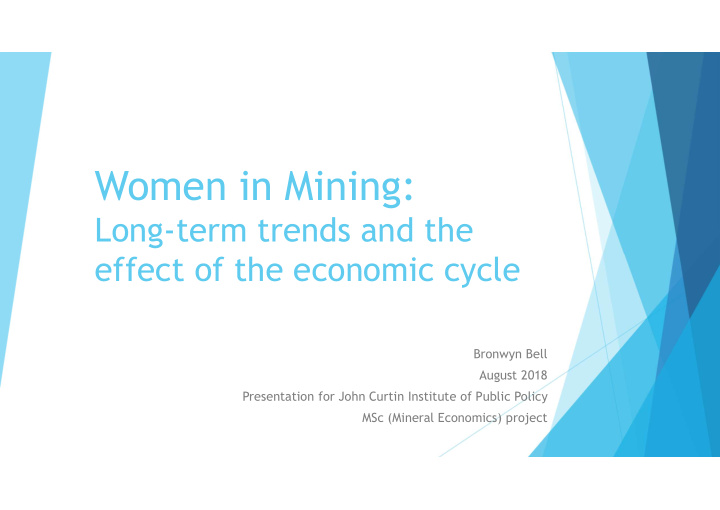



Women in Mining: Long-term trends and the effect of the economic cycle Bronwyn Bell August 2018 Presentation for John Curtin Institute of Public Policy MSc (Mineral Economics) project
Outline Context Long-term Australian and industry trends Effect of the recent boom and downturn Conclusions Note: “Mining” matches the ANZSIC Classification Includes Mining, Oil & Gas, Exploration & Services, excludes Smelting & Refining
Why this topic? Why Female Employment? Female participation in Australia increasing generally but still gaps Evidence of positive economic & other performance outcomes Increase labour supply and increase GDP Increased regulatory, shareholder, community and research focus Why Mining? Historically Australia’s most male-dominated industry 20+ years of industry-specific research and publications Industry self-focus: gender equality strategies / policies, targets, pay gap A once in a lifetime boom, the GFC and downturn
Data ABS Labour Force Survey 1984 – 2018 Sample WGEA Reports 2013-14, 2014-15 and 2015-16 Census non-public entities 100+ employees Good general alignment but some data limitations 2013-2014 2014-2015 2015-2016 % Female Employees Females % Female Employees Females % Female Employees Females WGEA 15.72% 190,171 29,895 15.96% 177,639 28,343 15.81% 148,724 23,507 ABS 15.15% 265,928 40,289 14.67% 234,445 34,304 13.78% 227,876 31,399
Female Employment in Australia Long-term Trends (1984 – 2018)
Australia (All Industries) Long Term Trend Female dominated: Females >60% Mixed gender: Females 40-60% All Australia Transition to Mixed Mining Male dominated: Females <40%
Is it Improving?
Do Mining sectors perform differently?
Key Points: Long term trends Australia has a gender segregated workforce Despite advances in female participation, limited change in segregation over 30+ years Science, Construction - going backwards Manufacturing, Wholesale going backwards - account for increased female employment Female employment in mining is low Has improved (slightly), accounting for increased Aust female employment Mining has probably caught up to Construction Different mining sectors perform differently Female employment in Exploration and Services declining
Mining: Boom and Bust and How to Change your Workforce
How to change your workforce? Gain employees Replacement & Growth % Female in Labour Force and other characteristics Losses Gain Lose employees Mining employees Resignations & Redundancies Workforce % Female existing workforce To Increase % Female: % F gains > % F workforce > % F losses
Mining employment: boom and bust “Downturn” GFC To Increase % Female: % F gains > % F workforce > % F losses
How did the economic cycle affect females? 19% 44% (22%) 32% (18%) 22% Percentages shown are % calculated from raw 22% (15%) 11% (2%) data and 12MRA (latter in brackets)
A model Increasing % Female A: B: Decline # Growth # >Females >Females Decreasing Increasing Employees Employees D: C: Retention / Redundancies Recruitment & Attraction • Distribution of females Industry Image • Decline # Growth # • Gendered roles Recruitment processes • • Site vs head office Selection criteria • <Females <Females Production vs support • Labour force • Part-time & flexible work • Location • Offshoring • • Job design Unconscious bias • • Services Decreasing • Unconscious bias % Female
Company performance varies Decline #, +ve %F 39 Growth #, +ve %F 18 Growth #, -ve %F 15 Decline #, -ve %F 48
Potential reasons? Culture, unconscious bias Females more likely to be part-time Higher % female in corporate offices than regional sites Detailed data not available Workforce Composition Comprise the majority of admin roles Clustered in certain professional / “support” roles Less likely to be trades, technicians, machine operators Less likely to be in management
Maybe it’s the role & how many? Females have higher representation in non- production roles. Companies that decreased female employment reduced these roles disproportionately more, with uneven losses across role-types in their workforce.
What works? Most companies have strategies and gender equality initiatives No clear link between strategies and performance: Time-lag? Implementation issues? Strategy effectiveness? Probably still a good start % Females in Management significant relationship with appt and promotion performance – not resign Cause vs effect?
Conclusions Mining has improved (slightly) but clearly male dominated) Female gains during boom but disproportionate loss during downturn Female employment is more responsive to economic cycles Failed to achieve step-change despite influx Change within a stable, larger workforce harder Performance between companies varies Those with more admin & prof do better, but roles lost during downturns % Female simplistic, masks vulnerabilities Need better distribution of females across roles No clear relationship between strategies and performance Significant relationship: % female mgr and non-mgr female appts and promotions
Further Research Construction declines, relationship to Mining? Case studies companies with dominant ABCD performance Strategies & policies vs implementation & effectiveness Remote site based vs corporate offices data collection Metrics for distribution of women in workforce How to improve distribution of women in workforce What will we achieve during this new upswing?
Questions? Thank you to the Workplace Gender Equality Agency for providing the their dataset
Recommend
More recommend